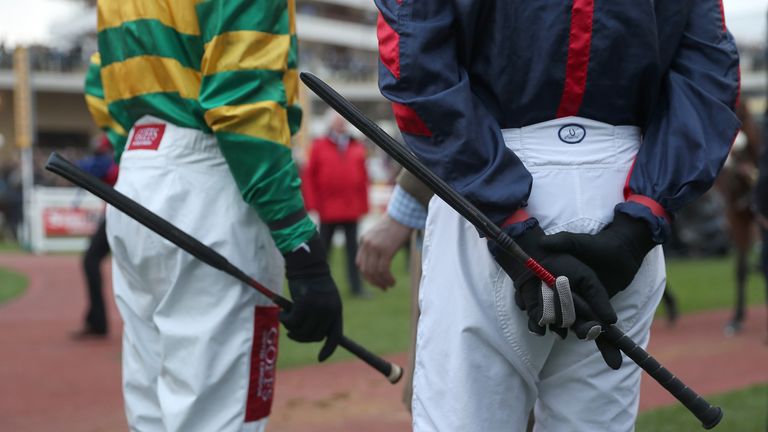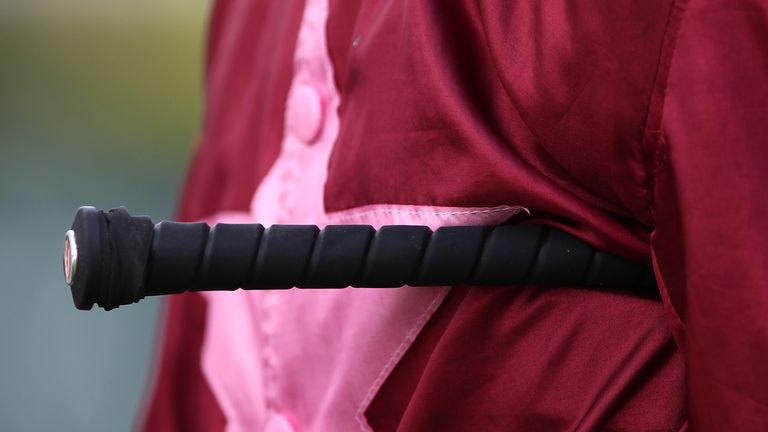Whip rule report: Board calls for disqualifications over serious breaches and restricted use for encouragement
Report calls for introduction of disqualifications for horses when a rider uses the whip four or more times above the permitted level; group also recommends restricting jockeys to backhand use of whip, unless for safety reasons
Tuesday 12 July 2022 15:01, UK
Racing’s whip rules could be set for a major overhaul with a review board calling for significant increases in penalties for serious breaches and restrictions on how jockeys use the whip for encouragement.
In a highly-anticipated report released by the British Horseracing Authority (BHA) on Tuesday, a Whip Consultation Steering Group - including senior industry figures such as trainer John Gosden and jockey Tom Scudamore - revealed its recommendations for changes to whip rules, regulation and penalties.
The group are calling for the introduction of disqualifications for horses when a rider uses the whip four or more times above the permitted level, which is set to remain at seven strikes for Flat jockeys and eight for Jump jockeys.
- Frankie Dettori confirmed for Shergar Cup
- 'Mum calls it character building' - Hornby's rollercoaster year
If a jockey strikes a horse four or more times in a major race, they face at least a month suspended, with the aim for implementation from August 2022.
In another significant conclusion, the board will recommend restricting jockeys to backhand use of the whip, unless for safety reasons.
Overall, the group concluded that racing's current penalty framework "does not provide a sufficient deterrent against breaches" and "needs to be stronger".
The group's recommendations for changes to penalties also includes doubling suspension for offences in "major" races, defined on both codes to include all Class 1 and Class 2 contests and any races exceeding a total prize fund of £27,500 for a Flat race or £20,000 for a Jump race.
Meanwhile, there was found to be little appetite for renaming the whip, in order to aid public understanding, but the report called on the racing industry to use "appropriate and responsible language" in relation to the whip.
In relation to the enforcement of the current whip regulations, the group ruled that current penalties were adequate but were not being enforced and applied consistently.
In 2020, a total of 297 whip offences were deemed to have occurred from that year's 73,872 rides, down 67 per cent on the 2010 figure.
Of those, 203 incidents resulted in suspensions of between 1-2 days, while just 26 offences led to bans of seven days or longer - up 13 per cent on 2010.
The Steering Group's findings followed an online consultation that received 2,147 responses, including 510 non-racegoers, 685 racegoer or television racing viewers, 149 jockeys and 429 racehorse owners.
In the concluding statement, the report said: "This has been a thorough, detailed review, achieving consensus on a package of measures across a group containing a range of opinion and expertise, and considering a range of complex factors.
"The Steering Group asks anyone discussing these recommendations to bear this in mind."
Current rules on 'acceptable use' of the whip
Any use of the whip by a jockey must be justified in the context of the race.
The whip may be used to encourage a horse to perform at its best only when the horse is in contention during the race, the horse is able to respond and the horse is given time by the jockey to respond.
Use of the whip for encouragement is not about simply making a horse run faster. It is to focus and concentrate a horse so that it performs at its best during a race.
The whip may only be used on the horse's body where, in the context of the race, it will not cause pain.
The stimulus provided by the whip must be limited, and the whip only used a certain number of times, so as not to compromise the welfare of the horse.
The whip used by all jockeys in Great Britain must be specifically designed energy absorbing whip that does not cause pain when properly used.
Is the whip a welfare issue?
The whip has changed and been developed hugely over the years, with the current foam-padded and energy-absorbing design created in collaboration with the RSPCA.
British racing uses just one accredited supplier to ensure all whips conform to the BHA's standards.
Whips are regularly checked by the clerk of the scales at racecourses to monitor their condition.







